| View previous topic :: View next topic |
| Author |
Message |
Gerald


Joined: 25 Mar 2014
Posts: 1196
Location: Brazil
|
 Posted: Tue Apr 01, 2014 5:39 pm Post subject: List of classic triplets and derivatives (Tessar, Sonnar...) Posted: Tue Apr 01, 2014 5:39 pm Post subject: List of classic triplets and derivatives (Tessar, Sonnar...) |
 |
|
Gerald wrote:
I hope the list below, with information about triplet lenses its and derivatives, are useful for people interested in these classic types of photographic lenses.
Excerpt from the 1979 Spanish edition of the original Photographic Optics, by Arthur Cox.
Enjoy it!
PS: Arthur Cox was a great connoisseur, but of course I can not guarantee absolute accuracy of all information presented in his book.
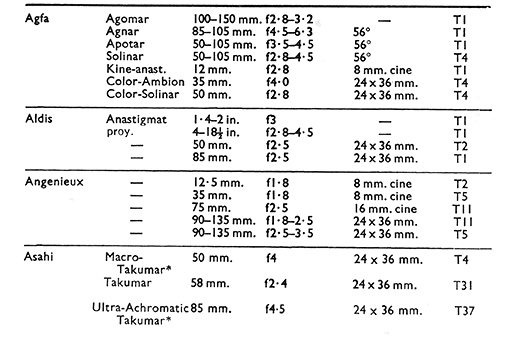


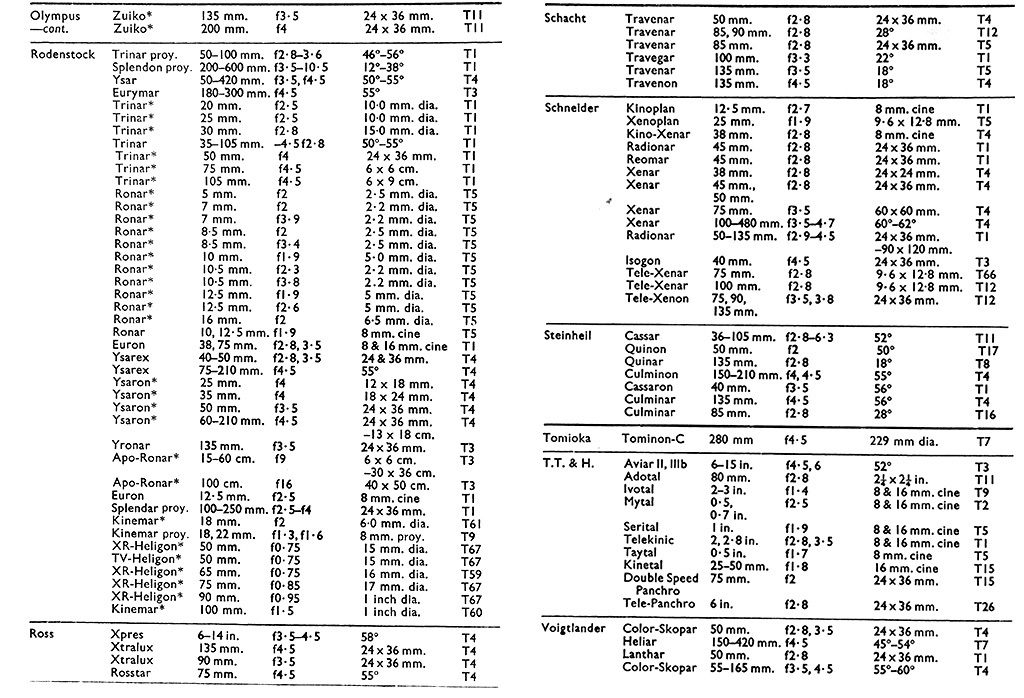
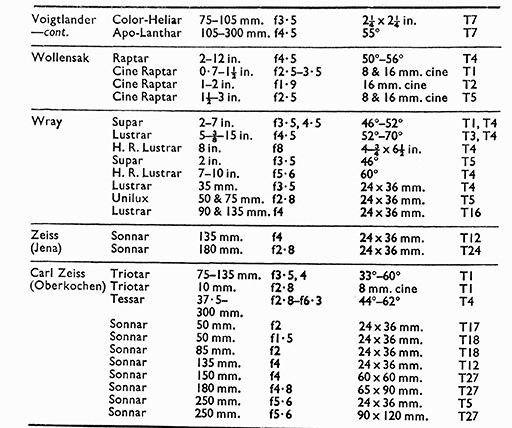
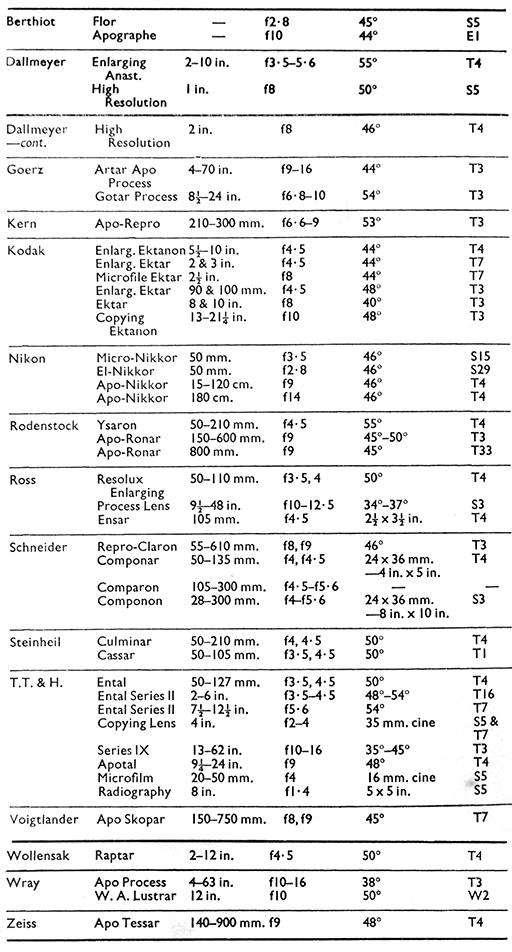
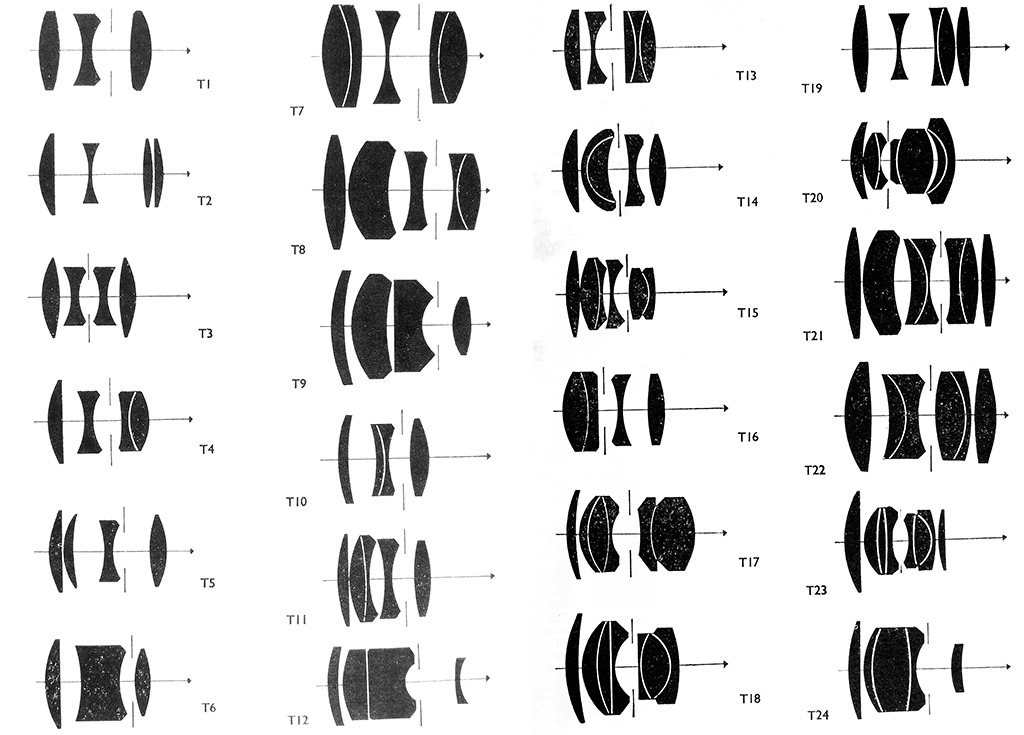
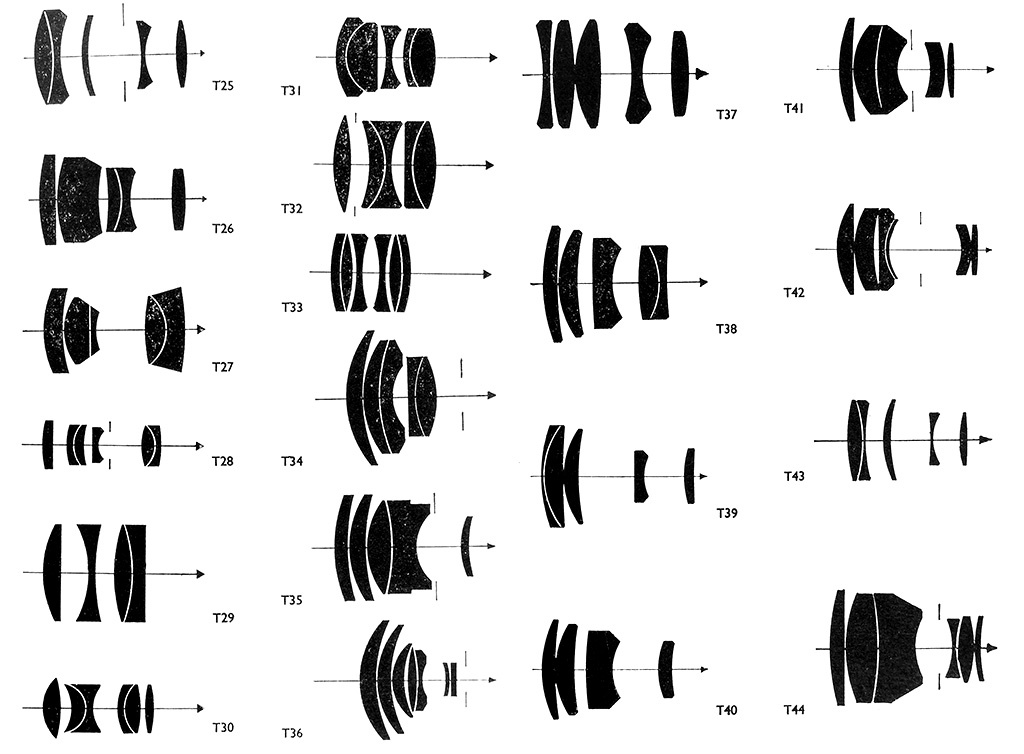

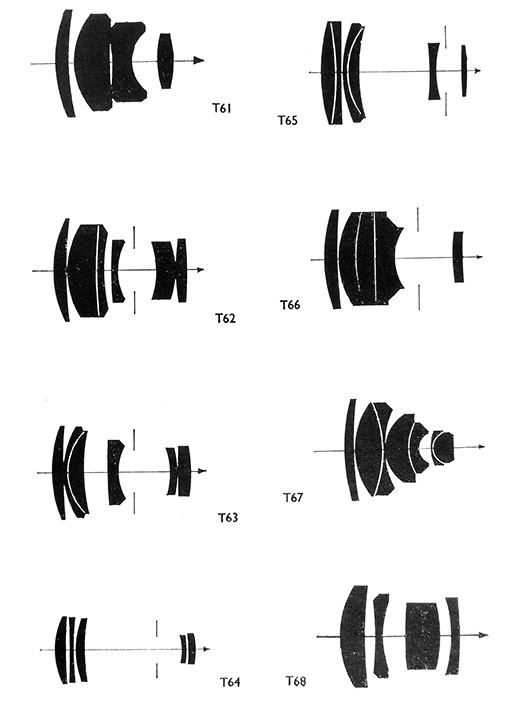
_________________
If raindrops were perfect lenses, the rainbow did not exist.
Last edited by Gerald on Sat Apr 16, 2016 6:04 pm; edited 2 times in total |
|
| Back to top |
|
 |
iangreenhalgh1


Joined: 18 Mar 2011
Posts: 15679
Expire: 2014-01-07
|
 Posted: Tue Apr 01, 2014 6:19 pm Post subject: Posted: Tue Apr 01, 2014 6:19 pm Post subject: |
 |
|
iangreenhalgh1 wrote:
Seems to be quite a few errors. In the Ross section, he lists the Rosstar 4.5/75 as a 4/3 tessar,it isn't, it's a triplet. The Xpres he lists as a 4/3 Tessar too, which is wrong, some are 5/3 with a cemented rear triplet, some are dialytes, some are double gauss, Xpres was just a trade name.
The Wray section is also wrong, he lists Supars as being both tessars and triplets, they are all triplets, and he lists the Lustrar as being both dialytes and tessars; Lustrar, like Xpres was a trade name and covered other designs too, I have a double gauss Lustrar, for instance.
In the Wollensak section he lists the Raptar as a tessar, again wrong as Raptar was also a trade name and covered several designs, I have a dialyte type Raptar and there are double gauss Raptars as well.
In the Kodak section he lists the Proy Ektanonas as triplets, this is wrong, some are dialytes. He also lists the Ektars as tessars, whereas some are Heliars.
The diagram T52 for the Isco S-Projar 2.5/90 is completely wrong, I have one of those lenses and have dismantled it, it is nothing like that diagram, it is an almost symmetrical 6 element design.
In the Aldis section he lists the Anastigmats as being triplets, well,most are, but some are Uno types with a cemented pair in front of the diaphragm and a single element behind.
Just the errors I spotted after a quick scan. Doesn't inspire confidence. 
_________________
I don't care who designed it, who made it or what country it comes from - I just enjoy using it! |
|
| Back to top |
|
 |
memetph

Joined: 01 Dec 2013
Posts: 940
Location: Poland
|
 Posted: Tue Apr 01, 2014 7:31 pm Post subject: Posted: Tue Apr 01, 2014 7:31 pm Post subject: |
 |
|
memetph wrote:
Nice document . Thank you.
The Zeiss Novar is absent.
There are articles explaining that the Tessar is not a derivative of a triplet. |
|
| Back to top |
|
 |
iangreenhalgh1


Joined: 18 Mar 2011
Posts: 15679
Expire: 2014-01-07
|
 Posted: Tue Apr 01, 2014 7:48 pm Post subject: Posted: Tue Apr 01, 2014 7:48 pm Post subject: |
 |
|
iangreenhalgh1 wrote:
The Novar was not a Carl Zeiss lens, it was a Zeiss Ikon lens, made ether in the Hensoldt factory or bought in from outside makers, Rodenstock are said to be the company who made many of them.
The Tessar is developed from the Unar and Protar, it is the back half of a Protar and the front half of a Unar.
Marco Cavina covers the Protar, Unar, Tessar progression here:
http://www.marcocavina.com/articoli_fotografici/Zeiss_cute_DFR_DDR_lenses/00_pag_English.htm
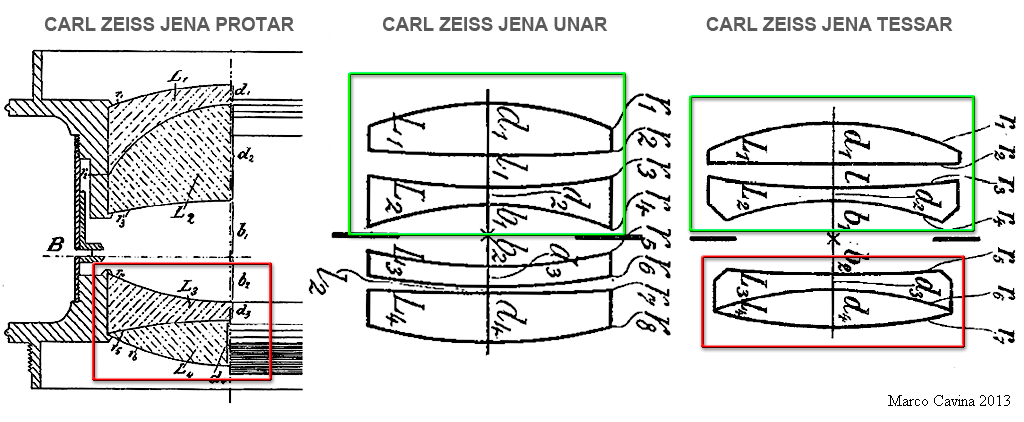
The 4/4 Dialyte/Aplanat type isn't derived from the triplet either. Goerz pioneered this type with the Syntor and Celor followed by the Dogmar and Artar. Steinheil were only a few years behind with their Unofokal. The Cooke Aviar which is also a 4/4 of this type was derived from the triplet though, during ww1 the British captured an example of the Tessar the Germans were using to make aerial maps and gave it to TT&H to copy. TT&H replied tat they couldn't copy it due to the glass types used not being available and instead submitted a superior design using available crown and flint glass. Almost all the early Kodak Anastigmats were 4/4 dialyte types too, they perform very differently to a triplet.
_________________
I don't care who designed it, who made it or what country it comes from - I just enjoy using it! |
|
| Back to top |
|
 |
memetph

Joined: 01 Dec 2013
Posts: 940
Location: Poland
|
 Posted: Tue Apr 01, 2014 8:10 pm Post subject: Posted: Tue Apr 01, 2014 8:10 pm Post subject: |
 |
|
memetph wrote:
I have two cameras equiped with a Novar : an Ikonta 4.5x6 and an Ikoflex TLR.
I have been using the Ikoflex many, many years ago in B&W. |
|
| Back to top |
|
 |
iangreenhalgh1


Joined: 18 Mar 2011
Posts: 15679
Expire: 2014-01-07
|
 Posted: Tue Apr 01, 2014 8:30 pm Post subject: Posted: Tue Apr 01, 2014 8:30 pm Post subject: |
 |
|
iangreenhalgh1 wrote:
Yes, the Novar is used on most Zeiss Ikon cameras in the lower price range. I have a Nettar 6x6 with a Novar 6.3/75. Stopped down to f11 the results are indistinguishable from those from my Ikonta 6x6 with a Tessar 4.5/75.
_________________
I don't care who designed it, who made it or what country it comes from - I just enjoy using it! |
|
| Back to top |
|
 |
Gerald


Joined: 25 Mar 2014
Posts: 1196
Location: Brazil
|
 Posted: Tue Apr 01, 2014 8:31 pm Post subject: Posted: Tue Apr 01, 2014 8:31 pm Post subject: |
 |
|
Gerald wrote:
| iangreenhalgh1 wrote: |
| The diagram T52 for the Isco S-Projar 2.5/90 is completely wrong, I have one of those lenses and have dismantled it, it is nothing like that diagram, it is an almost symmetrical 6 element design. |
I have an all-metal barrel Isco CINELUX-AV 90mm f/2.5 MC lens, which seems to have an optical construction exactly equal to T52, with 5 air-spaced lenses. I did not disassemble my lens, but I counted 10 reflections. I also estimated that the ratio of the diameters and radii of curvature of the frontal and rear lenses are compatible with the diagram T52.
I bought this lens in 1985, and it seems obvious to me now that the Isco at some point started to use the name CINELUX to replace Projar. What I know is that my lens appears to be exaclty equal the Projar of the diagram T52. All indications are that Isco had changed its name to CINELUX a few years before I bought it. Apparently the name Projar coexisted with CINELUX for a while, so Projar started to be used to designate the amateur line, while CINELUX was reserved for the professional line. As far as I know, today the name Projar no longer exists, but CINELUX continues.
I will not argue with you the other "mistakes" you detected because I never had those lenses, but I got the impression that you was misled by the loose naming system that lens manufacturers often employ. It is common for manufacturers to change completely a lens design, but the name remains the same. It is the case of the Nikkor 105mm F2.5 that was based on the Sonnar 180mm F2.8 (diagram T24), but was redesigned later to have an optical formula similar to the Pentacon 135mm F2.8.
_________________
If raindrops were perfect lenses, the rainbow did not exist. |
|
| Back to top |
|
 |
mo


Joined: 27 Aug 2009
Posts: 8979
Location: Australia
Expire: 2016-07-30
|
 Posted: Tue Apr 01, 2014 9:05 pm Post subject: Posted: Tue Apr 01, 2014 9:05 pm Post subject: |
 |
|
mo wrote:
How old is the book?,perhaps by "dating" the info it will give a better understanding of what era of lenses he was trying to catalogue at his time of life.
_________________
Moira, Moderator 
Fuji XE-1,Pentax K-01,Panasonic G1,Panasonic G5,Pentax MX
Ricoh Singlex TLS,KR-5,KR-5Super,XR-10
Lenses
Auto Rikenon's 55/1.4, 1.8, 2.8... 50/1.7 Takumar 2/58 Preset Takumar 2.8/105 Auto Takumar 2.2/55, 3.5/35 Super Takumar 1.8/55...Macro Takumar F4/50... CZJ Biotar ALU M42 2/58 CZJ Tessar ALU M42 2.8/50
CZJ DDR Flektogon Zebra M42 2.8/35 CZJ Pancolar M42 2/50 CZJ Pancolar Exakta 2/50
Auto Mamiya/Sekor 1.8/55 ...Auto Mamiya/Sekor 2/50 Auto Mamiya/Sekor 2.8/50 Auto Mamiya/Sekor 200/3.5 Tamron SP500/8 Tamron SP350/5.6 Tamron SP90/2.5
Primoplan 1.9/58 Primagon 4.5/35 Telemegor 5.5/150 Angenieux 3.5/28 Angenieux 3,5/135 Y 2
Canon FL 58/1.2,Canon FL85/1.8,Canon FL 100/3.5,Canon SSC 2.8/100 ,Konica AR 100/2.8, Nikkor P 105/2.5
|
|
| Back to top |
|
 |
Gerald


Joined: 25 Mar 2014
Posts: 1196
Location: Brazil
|
 Posted: Tue Apr 01, 2014 9:27 pm Post subject: Posted: Tue Apr 01, 2014 9:27 pm Post subject: |
 |
|
Gerald wrote:
| mo wrote: |
| How old is the book?,perhaps by "dating" the info it will give a better understanding of what era of lenses he was trying to catalogue at his time of life. |
I have just edited and added that information to my post.
_________________
If raindrops were perfect lenses, the rainbow did not exist. |
|
| Back to top |
|
 |
calvin83


Joined: 12 Apr 2009
Posts: 7581
Location: Hong Kong
|
 Posted: Wed Apr 02, 2014 3:38 am Post subject: Posted: Wed Apr 02, 2014 3:38 am Post subject: |
 |
|
calvin83 wrote:
Cassar and Zuiko 3.5/135 have similar optical construction. 
Some lens have few versions and have different optical design. For example, the Quinon 2/50 exist in LTM and M39 but they have totally different optical construction(Sonnar vs double Gauss).
_________________
The best lens is the one you have with you.
https://lensfever.com/
https://www.instagram.com/_lens_fever/ |
|
| Back to top |
|
 |
Gerald


Joined: 25 Mar 2014
Posts: 1196
Location: Brazil
|
 Posted: Wed Apr 02, 2014 2:22 pm Post subject: Posted: Wed Apr 02, 2014 2:22 pm Post subject: |
 |
|
Gerald wrote:
For the sake of completeness I added the process and enlarging lenses, as listed in the book of Arthur Cox. Many of these lenses are Triplets or Tessars, so that the diagrams shown before apply here.
It is interesting to note that the Stenheil Cassar reappears here, but with a construction type Triplet (diagram T1) and ranges of FLs and apertures different from that shown in the first list. This suggests that indeed Cassar had many versions with varying optical formulas. Another possibility is simply that there is a typo in the first list, causing T1 to turn into T11.

_________________
If raindrops were perfect lenses, the rainbow did not exist. |
|
| Back to top |
|
 |
iangreenhalgh1


Joined: 18 Mar 2011
Posts: 15679
Expire: 2014-01-07
|
 Posted: Sat Apr 05, 2014 2:16 pm Post subject: Posted: Sat Apr 05, 2014 2:16 pm Post subject: |
 |
|
iangreenhalgh1 wrote:
It will be a typo because every Cassar I've seen was a triplet.
_________________
I don't care who designed it, who made it or what country it comes from - I just enjoy using it! |
|
| Back to top |
|
 |
Gerald


Joined: 25 Mar 2014
Posts: 1196
Location: Brazil
|
 Posted: Sat Apr 16, 2016 10:58 pm Post subject: Posted: Sat Apr 16, 2016 10:58 pm Post subject: |
 |
|
Gerald wrote:
I've just rescued the list and optical diagrams of triplets and derivatives that were lost when the forum had a technical problem a few years ago.
_________________
If raindrops were perfect lenses, the rainbow did not exist. |
|
| Back to top |
|
 |
kds315*


Joined: 12 Mar 2008
Posts: 16661
Location: Weinheim, Germany
Expire: 2021-03-09
|
 Posted: Sat Apr 16, 2016 11:29 pm Post subject: Posted: Sat Apr 16, 2016 11:29 pm Post subject: |
 |
|
kds315* wrote:
| Gerald wrote: |
| I've just rescued the list and optical diagrams of triplets and derivatives that were lost when the forum had a technical problem a few years ago. |
Obrigado!!
_________________
Klaus - Admin
"S'il vient a point, me souviendra" [Thomas Bohier (1460-1523)]
http://www.macrolenses.de for macro and special lens info
http://www.pbase.com/kds315/uv_photos for UV Images and lens/filter info
https://www.flickr.com/photos/kds315/albums my albums using various lenses
http://photographyoftheinvisibleworld.blogspot.com/ my UV BLOG
http://www.travelmeetsfood.com/blog Food + Travel BLOG
https://galeriafotografia.com Architecture + Drone photography
Currently most FAV lens(es):
X80QF f3.2/80mm
Hypergon f11/26mm
ELCAN UV f5.6/52mm
Zeiss UV-Planar f4/60mm
Zeiss UV-Planar f2/62mm
Lomo Уфар-12 f2.5/41mm
Lomo Зуфар-2 f4.0/350mm
Lomo ZIKAR-1A f1.2/100mm
Nikon UV Nikkor f4.5/105mm
Zeiss UV-Sonnar f4.3/105mm
CERCO UV-VIS-NIR f1.8/45mm
CERCO UV-VIS-NIR f4.1/94mm
CERCO UV-VIS-NIR f2.8/100mm
Steinheil Quarzobjektiv f1.8/50mm
Pentax Quartz Takumar f3.5/85mm
Carl Zeiss Jena UV-Objektiv f4/60mm
NYE OPTICAL Lyman-Alpha II f1.1/90mm
NYE OPTICAL Lyman-Alpha I f2.8/200mm
COASTAL OPTICS f4/60mm UV-VIS-IR Apo
COASTAL OPTICS f4.5/105mm UV-Micro-Apo
Pentax Ultra-Achromatic Takumar f4.5/85mm
Pentax Ultra-Achromatic Takumar f5.6/300mm
Rodenstock UV-Rodagon f5.6/60mm + 105mm + 150mm
|
|
| Back to top |
|
 |
Gerald


Joined: 25 Mar 2014
Posts: 1196
Location: Brazil
|
 Posted: Sun Apr 17, 2016 12:32 am Post subject: Posted: Sun Apr 17, 2016 12:32 am Post subject: |
 |
|
Gerald wrote:
| kds315* wrote: |
| Gerald wrote: |
| I've just rescued the list and optical diagrams of triplets and derivatives that were lost when the forum had a technical problem a few years ago. |
Obrigado!! |
De nada! You're welcome!
_________________
If raindrops were perfect lenses, the rainbow did not exist. |
|
| Back to top |
|
 |
visualopsins


Joined: 05 Mar 2009
Posts: 11053
Location: California
Expire: 2025-04-11
|
 Posted: Fri Apr 16, 2021 10:48 pm Post subject: Posted: Fri Apr 16, 2021 10:48 pm Post subject: |
 |
|
visualopsins wrote:
    
_________________
☮☮☮☮☮☮☮☮☮☮☮☮☮☮☮☮☮☮☮☮☮☮☮☮☮☮☮☮☮☮☮☮ like attracts like! ☮☮☮☮☮☮☮☮☮☮☮☮☮☮☮☮☮☮☮☮☮☮☮☮☮☮☮☮☮☮☮☮
Cameras: Sony ILCE-7RM2, Spotmatics II, F, and ESII, Nikon P4
Lenses:
M42 Asahi Optical Co., Takumar 1:4 f=35mm, 1:2 f=58mm (Sonnar), 1:2.4 f=58mm (Heliar), 1:2.2 f=55mm (Gaussian), 1:2.8 f=105mm (Model I), 1:2.8/105 (Model II), 1:5.6/200, Tele-Takumar 1:5.6/200, 1:6.3/300, Macro-Takumar 1:4/50, Auto-Takumar 1:2.3 f=35, 1:1.8 f=55mm, 1:2.2 f=55mm, Super-TAKUMAR 1:3.5/28 (fat), 1:2/35 (Fat), 1:1.4/50 (8-element), Super-Multi-Coated Fisheye-TAKUMAR 1:4/17, Super-Multi-Coated TAKUMAR 1:4.5/20, 1:3.5/24, 1:3.5/28, 1:2/35, 1:3.5/35, 1:1.8/85, 1:1.9/85 1:2.8/105, 1:3.5/135, 1:2.5/135 (II), 1:4/150, 1:4/200, 1:4/300, 1:4.5/500, Super-Multi-Coated Macro-TAKUMAR 1:4/50, 1:4/100, Super-Multi-Coated Bellows-TAKUMAR 1:4/100, SMC TAKUMAR 1:1.4/50, 1:1.8/55
M42 Carl Zeiss Jena Flektogon 2.4/35
Contax Carl Zeiss Vario-Sonnar T* 28-70mm F3.5-4.5
Pentax K-mount SMC PENTAX-A ZOOM 1:3.5 35~105mm, SMC PENTAX ZOOM 1:4 45~125mm
Nikon Micro-NIKKOR-P-C Auto 1:3.5 f=55mm, NIKKOR-P Auto 105mm f/2.5 Pre-AI (Sonnar), Micro-NIKKOR 105mm 1:4 AI, NIKKOR AI-S 35-135mm f/3,5-4,5
Tamron SP 17mm f/3.5 (51B), Tamron SP 17mm f/3.5 (151B), SP 500mm f/8 (55BB), SP 70-210mm f/3.5 (19AH)
Vivitar 100mm 1:2.8 MC 1:1 Macro Telephoto (Kiron)
|
|
| Back to top |
|
 |
|
|
|
You cannot post new topics in this forum
You cannot reply to topics in this forum
You cannot edit your posts in this forum
You cannot delete your posts in this forum
You cannot vote in polls in this forum
|
